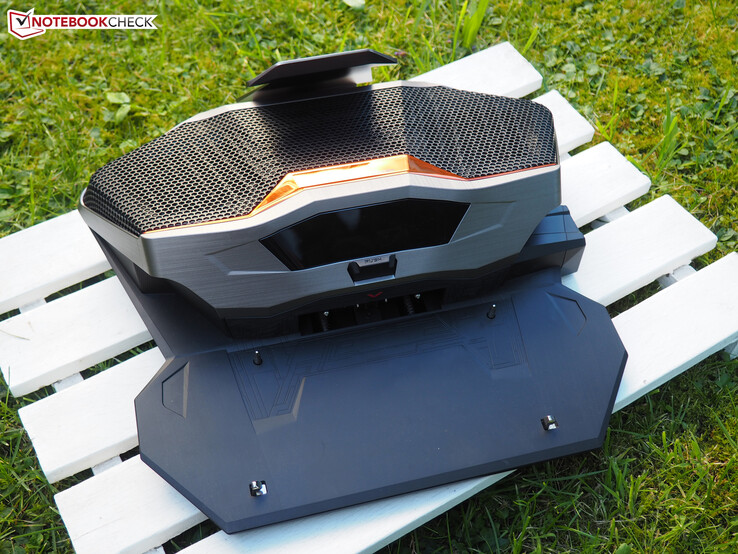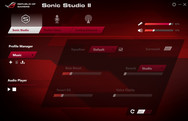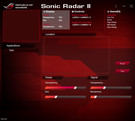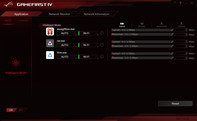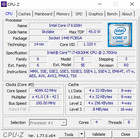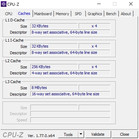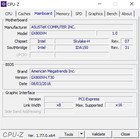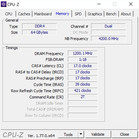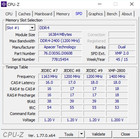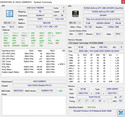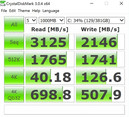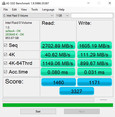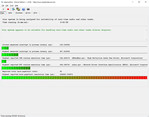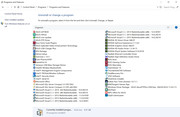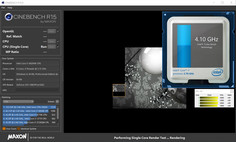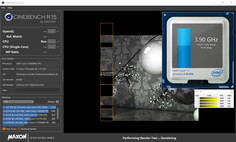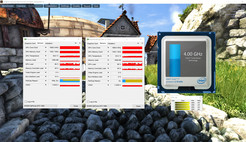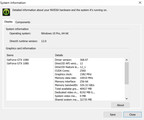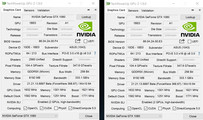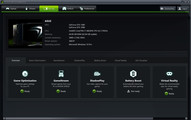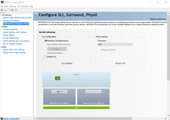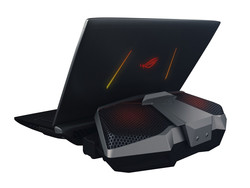Test Preview Asus ROG GX800VH Notebook
Dass Asus zu den mutigsten Laptop-Herstellern auf dem Markt gehört, sieht man besonders gut am Beispiel des GX700, welches Ende 2015 von uns getestet wurde. Der 17-zöllige High-End-Spross gab sich nicht mit konventionellen Lüftern zufrieden, sondern enthielt auch Leitungen für eine externe Wasserkühlung, genauer gesagt die Hydro Overclocking Station. Das spannende Konzept hatte zwar durchaus seine Schwächen (hoher Preis, enormes Gewicht, ...), an die Performance konnten jedoch nur wenige Notebooks heranreichen.
Um den Anforderungen des Jahres 2016 gerecht zu werden, bringt Asus in Kürze das nicht minder spektakuläre GX800 heraus. Das Desktop-Replacement trumpft einerseits mit einem größeren Display (18,4 Zoll) und andererseits mit deutlich mehr Power auf. Statt einer GTX 980 übernehmen jetzt zwei Nvidia GPUs die Grafikberechnungen. Während sich der erste Prototyp, den uns Asus vor ein paar Wochen zur Verfügung gestellt hatte, noch mit der Maxwell-Generation abfinden musste, basiert der frische Prototyp auf der brandneuen Pascal-Architektur. Zwei GTX-1080-Chips im SLI-Modus sind das schnellste, was der Laptop-Bereich derzeit hergibt.
Damit der Dual-GPU-Verbund nicht ausgebremst wird, hatte das Testgerät ganze 64 GByte DDR4-RAM (4x 16 GB @2.400 MHz) und einen übertakteten Quad-Core-Prozessor von Intel unter der Haube (Core i7-6820HK). Das integrierte IPS-Panel löste mit 3.840 x 2.160 Pixeln, sprich UHD auf.
Übersicht
Da neben der Verarbeitung und der Tastatur auch das Display und die Software noch nicht final sind, verzichten wir – analog zur ersten Preview – auf eine ausführliche Beurteilung des GX800 und konzentrieren uns vornehmlich auf den Leistungsaspekt. Wenn Sie mehr zum Gehäuse, der Ausstattung und den Eingabegeräten etc. erfahren möchten, klicken Sie bitte auf den folgenden Link. Dort geben wir zu vielen Kategorien eine grobe Einschätzung.
Eine der wichtigsten Neuerungen ist das überarbeitete Gaming Center, das nun deutlich moderner und stylisher wirkt (vergleiche Screenshots). Aufgrund der zahlreichen Features benötigt man allerdings eine Weile, um sich an das Programm zu gewöhnen.
Als größtes Highlight entpuppt sich das Menü Turbo Gear. Im Gegensatz zu anderen Herstellern belässt es Asus nicht bei den automatischen Overclocking-Funktionen von Prozessor und Grafikkarte, sondern übertaktet diese Komponenten zusätzlich. Wenn man den Extreme-Modus wählt, klettert der Core i7-6820HK von standardmäßig 2,7 bis 3,6 GHz auf maximal 4,2 GHz – ein üppiger Wert für eine Notebook-CPU.
Die beiden Pascal-Chips erhalten ebenfalls einen Performance-Boost. Statt 1.582-1.771 MHz (Kern) respektive 5.000 MHz (VRAM) läuft die GTX 1080 mit 1.632-1.821 und 5.200 MHz. Bei diesen Taktraten ist aber noch nicht Schluss. Dank der cleveren Architektur sind – je nach Kühlsystem – weitaus höhere Werte möglich. Unserem Presample konnten wir im Render-Test des Tools GPU-Z bis zu 1.950 MHz entlocken! Durchschnittlich 1.900 MHz nach zwei Durchläufen im Unigine Heaven Benchmark verdienen auch Respekt.
Doch zurück zum Gaming Center. Mithilfe der Schnellzugriffsleiste am unteren Rand gelangt man komfortabel zu weiteren Software-Bestandteilen. Sei es nun ROG Macro Key für die Konfiguration der Sondertasten oder ROG Aura zum Tuning der Keyboard-Beleuchtung. Auf das Lüfterverhalten des Notebooks und der externen Wasserkühlung (letztere ist zum Betrieb nicht zwingend nötig) hat man per Fan Boost ebenso Einfluss. Andere Tools betreffen den Sound (Sonic Studio) oder die Kommunikation (ROG GameFirst).
Leistung
Das Leistungs-Kapitel eröffnen wir mit einer Reihe von System-Screenshots, die alle wichtigen Komponenten von CPU und RAM bis hin zum Massenspeicher abbilden. Bleibt abzuwarten, welche davon auch im Serienprodukt stecken. Es ist natürlich eine Review zum fertigen Modell geplant.
Prozessor
Während die meisten Gaming-Notebooks auf den Core i7-6700HQ vertrauen, enthält das GX800 einen Core i7-6820HK, der 8 statt 6 MByte L3-Cache, einen freien Multiplikator (erleichtert OC) und 2,7-3,6 statt 2,6-3,5 GHz Grundtakt bietet.
Ansonsten ähneln sich die Vierkern-Modelle aus Intels Skylake-Generation recht stark. Neben der TDP (45 Watt) ist auch das Herstellungsverfahren (14 nm) identisch. Asus hebt sich allerdings nicht primär durch den CPU-Typ, sondern durch die bereits angesprochene Übertaktung von der Konkurrenz ab. Letztere beschert dem GX800 eine Spitzenleistung auf Desktop-Niveau.
Der Cinebench R15 und der Cinebench R11.5 ordnen den Core i7-6820HK im Multi-CPU-Test knapp über dem Level des Core i7-6700 ein, der unter Last zwischen 3,4 und 4,0 GHz taktet. Notebooks mit Core i7-6700HQ wie das MSI GT62VR werden in Prozessor-Benchmarks 26 % besiegt. Der Grafikchip des Core i7-6820HK (HD Graphics 530) ist wegen SLI inaktiv, es existiert also keine Umschaltfunktion per Optimus.
| Cinebench R15 | |
| CPU Single 64Bit | |
| MSI GT80S 6QF | |
| Schenker XMG U726 | |
| Asus GX800VH Prototype | |
| Asus G800VI Prototype | |
| MSI GT62VR-6RE16H21 | |
| CPU Multi 64Bit | |
| MSI GT80S 6QF | |
| Asus GX800VH Prototype | |
| Schenker XMG U726 | |
| Asus G800VI Prototype | |
| MSI GT62VR-6RE16H21 | |
| Cinebench R11.5 | |
| CPU Single 64Bit | |
| MSI GT80S 6QF | |
| Schenker XMG U726 | |
| Asus GX800VH Prototype | |
| Asus G800VI Prototype | |
| MSI GT62VR-6RE16H21 | |
| CPU Multi 64Bit | |
| MSI GT80S 6QF | |
| Asus GX800VH Prototype | |
| Schenker XMG U726 | |
| Asus G800VI Prototype | |
| MSI GT62VR-6RE16H21 | |
System Performance
Wenig überraschend siedelt sich das GX800 bei System-Tests am oberen Ende des Leistungsspektrums an. 7.517 Punkte im PCMark 7 sind ein erstklassiges Ergebnis, das kaum ein High-End-Notebook übertrumpft. Die meisten Gaming-Laptops rangieren zwischen 6.000 und 7.000 Punkten.
| PCMark 7 Score | 7517 Punkte | |
Hilfe | ||
Massenspeicher
Für den exzellenten PCMark-Score ist vor allem der RAID-0-Verbund verantwortlich, der beim Testgerät aus zwei PCIe-SSDs bestand (das Topmodell soll 3 Solid State Drives besitzen). Im Vergleich zu Notebooks mit Single-SSD schneidet das GX800 deutlich besser ab.
Rund 2.700 MB/Sek beim sequentiellen Lesen und 1.600 MB/Sek beim sequentiellen Schreiben (AS SSD Benchmark) sind für ein SATA-III-Modell unerreichbar. So kommt die Testkonfiguration des MSI GT62VR nur auf 502 respektive 456 MB/Sek. Der CrystalDiskMark attestiert dem GX800 sogar über 3.100 bzw. 2.100 MB/Sek. Okay, bei kompakten Dateien, die im Windows Alltag eine größere Rolle spielen, schrumpft der Abstand, nichtsdestotrotz sind SSD-RAIDs für Hardware-Fetischisten ein nettes Detail.
| Asus GX800VH Prototype | Asus G800VI Prototype | MSI GT62VR-6RE16H21 Toshiba HG6 THNSNJ256G8NY | MSI GT80S 6QF 2x Samsung SM951 MZVPV256HDGL (RAID 0) | Schenker XMG U726 Samsung SM951 MZHPV512HDGL m.2 PCI-e | |
|---|---|---|---|---|---|
| AS SSD | -0% | -59% | 13% | -17% | |
| Seq Read (MB/s) | 2703 | 2895 7% | 502 -81% | 2892 7% | 1943 -28% |
| Seq Write (MB/s) | 1605 | 1537 -4% | 455.5 -72% | 2408 50% | 1500 -7% |
| 4K Read (MB/s) | 40.62 | 40.17 -1% | 20.08 -51% | 44.96 11% | 40.45 0% |
| 4K Write (MB/s) | 111.3 | 114.3 3% | 89.9 -19% | 109.9 -1% | 103.6 -7% |
| Score Total (Points) | 3327 | 3096 -7% | 915 -72% | 3336 0% | 1930 -42% |
Grafikkarte
Apropos nett: Bei den Grafikchips hält sich Asus nach dem Leitspruch »klotzen statt kleckern«. Wer hinsichtlich der Bildqualität auch im 4K-Bereich keinerlei Kompromisse eingehen möchte und regelmäßig den Treiber aktualisiert, ist der perfekte Kandidat für einen SLI-Verbund.
Das GX800 lässt hier nichts anbrennen und verwöhnt Käufer mit den stärken High-End-GPUs, welche man aktuell im Notebook-Segement findet. Nvidias 16-nm-Modell GeForce GTX 1080 hat es mit 2.560 Shadern, 8 GByte GDDR5X-VRAM und einem 256 Bit breiten Speicherinterface auf passionierte Zocker abgesehen, die gerne alle Regler auf Maximum stellen. Dem bisherigen Laptop-König, der GTX 980, waren nur 2.048 Shader und ordinäres GDDR5-VRAM vergönnt.
Jedoch punktet die neue GPU-Architektur auch abseits der Leistung. Dank unzähliger Verbesserungen ist Pascal viel sparsamer als die alte Maxwell-Generation, was leisere und/oder flachere Geräte erlaubt. Im Doppelpack hat die GeForce GTX 1080 dennoch Schwächen, wie man sie auch von anderen Dual-GPU-Notebooks kennt. Sei es nun der hohe Kühl- und Energiebedarf (das GX800 benötigt zwei 330-Watt-Netzteile, die jeweils über 1,2 Kilo wiegen) oder die Mikroruckler-Thematik, welche den 18-Zoll-Spross zum Glück eher selten betrifft.
Hinzu kommt die schwankende Performance. Wenn im Treiber ein passendes SLI-Profil fehlt oder ein Titel generell kein Dual-GPU unterstützt, bringt die zweite GTX 1080 nichts und sorgt im schlimmsten Fall sogar für schlechtere Framerates, als man sie bei einer Single-Chip-Lösung hätte. Von 22 Spielen, die in 4K getestet wurden, profitierten nur 12 stark durch die sekundäre GPU (>50 % Performance-Plus). 5 waren zwischen 10 und 50 % flotter, 5 (Just Cause 3, Rainbow Six Siege, Anno 2205, Fifa 16 und Batman Arkham Knight) harmonierten überhaupt nicht mit SLI. Ergo: Im Gaming-Umfeld macht das GX800 eine durchwachsene Figur, wenngleich dieses Resümee für alle Dual-GPU-Notebooks gilt.
| 3DMark Vantage P Result | 55056 Punkte | |
| 3DMark 11 Performance | 25328 Punkte | |
| 3DMark Fire Strike Score | 22020 Punkte | |
| 3DMark Time Spy Score | 10294 Punkte | |
Hilfe | ||
Bei synthetischen Grafik-Benchmarks kommt der 18-Zöller voll zur Geltung. Mit 13.013 Punkten schafft das SLI-Duo im brandneuen Time-Spy-Test des 3DMark einen 90 % höheren GPU-Score als eine Single-GTX-1080. Die GTX 1070 wird knapp 150 % abgehängt. Selbst zwei GTX-980-Chips tun sich schwer. Im Fire-Strike-Test sprintet das GX800 fast 70 % am MSI GT80S 6QF vorbei (GPU-Score: 39.221 vs. 23.351 Punkte). Kurzum: Asus hat ein beinah konkurrenzlos flottes Gerät erschaffen, das die Messlatte ein ganzes Stück höher legt.
Als Treiber nutzten wir übrigens die auf dem Testgerät vorinstallierte Version 368.97, welche insgesamt gute Dienste leistete (kaum Grafikfehler oder Abstürze). Der kurz vor dem Pascal-Launch veröffentlichte Nvidia Treiber 372.53 rüttelt – wenn überhaupt – nur minimal an der Performance. Mit letzterem absolvierte das GX800 unseren Steam-Parcours, Origin- und Uplay-Games wurden auf Basis der ForceWare 368.97 getestet.
| 3DMark | |
| 1920x1080 Fire Strike Graphics | |
| Asus GX800VH Prototype | |
| MSI GT80S 6QF | |
| Asus G800VI Prototype | |
| MSI GT62VR-6RE16H21 | |
| Schenker XMG U726 | |
| 2560x1440 Time Spy Graphics | |
| Asus GX800VH Prototype | |
| Asus G800VI Prototype | |
| MSI GT62VR-6RE16H21 | |
| 3DMark 11 - 1280x720 Performance GPU | |
| Asus GX800VH Prototype | |
| MSI GT80S 6QF | |
| Asus G800VI Prototype | |
| MSI GT62VR-6RE16H21 | |
| Schenker XMG U726 | |
| Unigine Heaven 4.0 - Extreme Preset DX11 | |
| Asus GX800VH Prototype | |
| Asus G800VI Prototype | |
| MSI GT80S 6QF | |
| MSI GT62VR-6RE16H21 | |
| Schenker XMG U726 | |
Gaming Performance
Bei Spiele-Benchmarks kristallisiert sich heraus, dass der Vorteil einer zweiten Grafikkarte umso geringer wird, je kräftiger das Single-Modell ist. Kam die GTX 980 SLI des ersten Protopyen noch auf eine Leistungssteigerung von knapp 60 %, sind es bei der GTX 1080 SLI nur durchschnittlich 40 %, obwohl einige Titel über 70 % an Frames zulegen (Battlefield 4, Star Wars Battlefront, The Witcher 3, Mad Max, Call of Duty Black Ops 3, XCOM 2, Fallout 4, Overwatch). Trotz des kleineren Performance-Boosts überflügelt das Pascal-Gespann zwei GTX-980-Chips um ca. 50 %, was sehr beachtlich ist.
| Vorsprung der GTX 1080 SLI(4K/High) | Vergleichs-Grafikkarte |
|---|---|
| +39 % vs. | GeForce GTX 1080 Notebook |
| +49 % vs. | GeForce GTX 980 SLI Notebook |
| +85 % vs. | GeForce GTX 1070 Notebook |
| +138 % vs. | GeForce GTX 980 Notebook |
Um die Einstellungen muss man sich in den meisten Titeln keine Sorgen machen. Unabhängig von der Auflösung packt das GX800 stets hohe oder maximale Settings und zaubert ein flüssiges Bild auf den Monitor. Auch mit 3.840 x 2.160 Pixeln erreichte der 18-Zöller mindestens 50 fps.
| Mirror's Edge Catalyst - 3840x2160 High Preset AF:16x | |
| Asus GX800VH Prototype | |
| Asus GX800 Prototype | |
| Asus G800VI Prototype | |
| MSI GT62VR-6RE16H21 | |
| Asus GX800 Prototype | |
| Overwatch - 3840x2160 High (Render Scale 100 %) AA:SM AF:4x | |
| Asus GX800VH Prototype | |
| Asus GX800 Prototype | |
| Asus G800VI Prototype | |
| MSI GT62VR-6RE16H21 | |
| Asus GX800 Prototype | |
| Doom - 3840x2160 High Preset AA:FX | |
| Asus GX800VH Prototype | |
| Asus GX800 Prototype | |
| Asus G800VI Prototype | |
| MSI GT62VR-6RE16H21 | |
| Asus GX800 Prototype | |
| Need for Speed 2016 - 3840x2160 High / On AA:FX | |
| Asus GX800VH Prototype | |
| Asus GX800 Prototype | |
| Asus G800VI Prototype | |
| MSI GT62VR-6RE16H21 | |
| Asus GX800 Prototype | |
| Hitman 2016 - 3840x2160 High / On AA:FX AF:8x | |
| Asus GX800VH Prototype | |
| Asus GX800 Prototype | |
| Asus G800VI Prototype | |
| MSI GT62VR-6RE16H21 | |
| Asus GX800 Prototype | |
| The Division - 3840x2160 High Preset AF:8x | |
| Asus GX800VH Prototype | |
| Asus GX800 Prototype | |
| Asus G800VI Prototype | |
| MSI GT62VR-6RE16H21 | |
| Asus GX800 Prototype | |
| Far Cry Primal - 3840x2160 High Preset AA:SM | |
| Asus GX800VH Prototype | |
| Asus GX800 Prototype | |
| Asus G800VI Prototype | |
| MSI GT62VR-6RE16H21 | |
| Asus GX800 Prototype | |
| XCOM 2 - 3840x2160 High Preset AA:FX AF:8x | |
| Asus GX800VH Prototype | |
| Asus GX800 Prototype | |
| Asus G800VI Prototype | |
| MSI GT62VR-6RE16H21 | |
| Asus GX800 Prototype | |
| Rise of the Tomb Raider - 3840x2160 High Preset AA:FX AF:4x | |
| Asus GX800VH Prototype | |
| Asus GX800 Prototype | |
| Asus G800VI Prototype | |
| MSI GT62VR-6RE16H21 | |
| Asus GX800 Prototype | |
| Just Cause 3 - 3840x2160 High / On AA:FX AF:8x | |
| Asus G800VI Prototype | |
| Asus GX800VH Prototype | |
| Rainbow Six Siege - 3840x2160 High Preset AA:T AF:4x | |
| Asus G800VI Prototype | |
| MSI GT62VR-6RE16H21 | |
| Asus GX800VH Prototype | |
| MSI GT80S 6QF | |
| Assassin's Creed Syndicate - 3840x2160 High Preset AA:FX | |
| Asus GX800VH Prototype | |
| Asus G800VI Prototype | |
| MSI GT80S 6QF | |
| MSI GT62VR-6RE16H21 | |
| Schenker XMG U716 | |
| Star Wars Battlefront - 3840x2160 High Preset AA:FX | |
| Asus GX800VH Prototype | |
| Asus G800VI Prototype | |
| MSI GT80S 6QF | |
| MSI GT62VR-6RE16H21 | |
| Schenker XMG U716 | |
| Fallout 4 - 3840x2160 High Preset AA:T AF:16x | |
| Asus GX800VH Prototype | |
| MSI GT80S 6QF | |
| Asus G800VI Prototype | |
| MSI GT62VR-6RE16H21 | |
| Schenker XMG U716 | |
| Call of Duty: Black Ops 3 - 3840x2160 High / On AA:FX | |
| Asus GX800VH Prototype | |
| MSI GT80S 6QF | |
| Asus G800VI Prototype | |
| MSI GT62VR-6RE16H21 | |
| Schenker XMG U716 | |
| Anno 2205 - 3840x2160 High Preset AA:4x | |
| Asus GX800VH Prototype | |
| Asus G800VI Prototype | |
| MSI GT62VR-6RE16H21 | |
| MSI GT80S 6QF | |
| Schenker XMG U716 | |
| FIFA 16 - 3840x2160 High Preset AA:2x MS | |
| Asus GX800VH Prototype | |
| Asus G800VI Prototype | |
| MSI GT62VR-6RE16H21 | |
| Schenker XMG U716 | |
| MSI GT80S 6QF | |
| Mad Max - 3840x2160 High Preset AF:6x | |
| Asus GX800VH Prototype | |
| Asus G800VI Prototype | |
| Schenker XMG U716 | |
| Batman: Arkham Knight - 3840x2160 High / On (Interactive Smoke & Paper Debris Off) AA:SM AF:8x | |
| Asus GX800VH Prototype | |
| Asus G800VI Prototype | |
| MSI GT62VR-6RE16H21 | |
| Schenker XMG U716 | |
| MSI GT80S 6QF | |
| The Witcher 3 - 3840x2160 High Graphics & Postprocessing (Nvidia HairWorks Off) | |
| Asus GX800VH Prototype | |
| MSI GT80S 6QF | |
| Asus G800VI Prototype | |
| MSI GT62VR-6RE16H21 | |
| Schenker XMG U716 | |
| Dirt Rally - 3840x2160 High Preset | |
| Asus GX800VH Prototype | |
| Asus G800VI Prototype | |
| MSI GT80S 6QF | |
| Schenker XMG U716 | |
| Battlefield 4 - 3840x2160 High Preset | |
| Asus GX800VH Prototype | |
| MSI GT80S 6QF | |
| Asus G800VI Prototype | |
| MSI GT62VR-6RE16H21 | |
| Schenker XMG U716 | |
| min. | mittel | hoch | max. | 4K | |
|---|---|---|---|---|---|
| Crysis 3 (2013) | 101 | ||||
| BioShock Infinite (2013) | 194 | ||||
| Metro: Last Light (2013) | 140 | ||||
| Battlefield 4 (2013) | 200 | 170 | |||
| Thief (2014) | 120 | ||||
| Watch Dogs (2014) | 75.6 | 67.1 | |||
| GRID: Autosport (2014) | 166 | 136 | |||
| Sims 4 (2014) | 150 | 142 | |||
| Alien: Isolation (2014) | 244 | 234 | |||
| Dragon Age: Inquisition (2014) | 174 | 163 | |||
| Dirt Rally (2015) | 162 | 161 | 155 | ||
| The Witcher 3 (2015) | 177 | 115 | 87.2 | ||
| Batman: Arkham Knight (2015) | 143 | 95 | 58 | ||
| Mad Max (2015) | 263 | 261 | 168 | ||
| FIFA 16 (2015) | 306 | 219 | |||
| Anno 2205 (2015) | 102 | 57.1 | 68.4 | ||
| Call of Duty: Black Ops 3 (2015) | 137 | 136 | 105 | ||
| Fallout 4 (2015) | 132 | 129 | 92.2 | ||
| Star Wars Battlefront (2015) | 198 | 195 | 132 | ||
| Assassin's Creed Syndicate (2015) | 88.3 | 80 | 71.7 | ||
| Rainbow Six Siege (2015) | 177 | 161 | 61.1 | ||
| Just Cause 3 (2015) | 125 | 115 | 57.6 | ||
| Rise of the Tomb Raider (2016) | 81.6 | 80.3 | 78.4 | ||
| XCOM 2 (2016) | 95 | 84.1 | 59.4 | ||
| Far Cry Primal (2016) | 71 | 70 | 69 | ||
| The Division (2016) | 138 | 124 | 75.7 | ||
| Hitman 2016 (2016) | 60.9 | 60 | 57.4 | ||
| Need for Speed 2016 (2016) | 107 | 99.2 | 92.8 | ||
| Doom (2016) | 139 | 136 | 83.2 | ||
| Overwatch (2016) | 294 | 292 | 215 | ||
| Mirror's Edge Catalyst (2016) | 115 | 113 | 67.3 |
Fazit
Egal, ob man eine externe Wasserkühlung für Notebooks als sinnvoll oder übertrieben erachtet, liefert Asus mit dem GX800 eine sehr beeindruckende Vorstellung ab. Größte Attraktion ist wie erwartet der SLI-Verbund aus zwei GTX-1080-Chips, der waschechten High-End-PCs in Tower-Form Konkurrenz macht.
Wer mit den typischen Nachteilen einer Dual-GPU-Lösung (Treiberabhängigkeit, Mikroruckler, hoher Energieverbrauch) leben kann, erhält eine äußerst potente Gaming-Plattform, die in den nächsten Jahren genug Power für anspruchsvollste Games bereithalten sollte.
Jedoch lohnen sich die beiden Luxus-Chips auch erst ab einer 3K- oder 4K-Auflösung. Beim Einsatz von 1.920 x 1.080 Pixeln bringt SLI nur selten spürbare Vorteile, da bereits eine GTX 1080 ausreichend Frames schafft, das System ins CPU-Limit läuft oder andere Faktoren die Leistung limitieren. Selbst mit 3.840 x 2.160 Pixeln profitiert das GX800 manchmal kaum von SLI, was häufig nicht am Treiber, sondern am fehlenden oder eingeschränkten Dual-GPU-Support der Spiele liegt.
Laut unseren 4K-Tests ist das GX800 im Schnitt 40 % flotter als ein Notebook mit Single-GTX-1080. Ob der Performance-Sprung den Verkaufspreis und den Platzbedarf der Flüssigkühlung rechtfertigt, muss jeder Spieler für sich entscheiden. Barebone-Produzent Clevo will die GTX 1080 SLI übrigens im P870DM-Chassis bändigen - allerdings mit reiner Luftkühlung.



